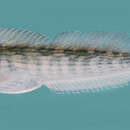Comprehensive Description
(
İngilizce
)
Smithsonian Contributions to Zoology tarafından sağlandı
Istiblennius pox
DIAGNOSIS (see also Tables 22 to 26).—A species of the Lineatus complex in which males have spotted occipital crest; females lack crest or, rarely, have low ridge-like crest; color pattern on caudal peduncle of both sexes consisting of fine, dark lines, dashes, and/or squiggles; dark stripes usually present on anterior half of body of both sexes; total dorsal-fin elements of males 34 to 36 (usually 34 or 35), of females 33 to 35; total vertebrae 39 to 41 (usually 40 or 41 in males, 39 or 40 in females).
HOLOTYPE.—USNM 296480, male, ~98 mm SL, tidepools at Boleiji Pt (Karachi), Pakistan, 3 March 1978, S.M. Shamsul Hoda. Dorsal fin XIII,22, attached to point out on dorsal edge of caudal fin 23.3% length of fin; anal fin II,24, last ray not split to base, free from caudal peduncle; pectoral fins 14/14; vertebrae 10+31; caudal fin 13, dorsal and ventral procurrent rays each 7; terminal pleural rib on 11th vertebra; terminal epineural on 19th vertebra; continuous portion of lateral line extending posteriorly to vertical from between 7th and 8th dorsal-fin spines; 6 bi-pored lateral-line tubes in skin, posteriormost below vertical from 12th dorsal-fin spine; mandibular pores .
ETYMOLOGY.—Pox is a varietal spelling of the English pocks, an eruptive disease such as chicken pox, referring also to spots resembling the disease eruptions, and, in the present case, to the spots on the occipital crest of males of the species; here used as a noun in apposition.
COMPARISONS.—See discussion beginning with second paragraph in introductory section on Lineatus species complex.
DISTRIBUTION (Figure 68).—Istiblennius pox is distributed from the Persian Gulf, southeastern Pakistan, and northern Arabian Gulf, westward to the gulfs of Aden and Tadjoura and into the southernmost Red Sea. Day (1876:332, as Salarias lineatus) reported I. pox from the Red Sea, without specific locality, and Giglioli (1888:70, also as S. lineatus) reported it from Assab, which is just northwest of the entrance to the Red Sea. We have seen only two specimens (both females) from the Red Sea, Dahlak Archipelago, off the coast of Eritrea. In the Red Sea, the species appears to be restricted to the southernmost portion, and is possibly a recent immigrant. Of possible significance is its replacement in the northern half of the Red Sea by the possibly related I. rivulatus, which is restricted to that area.
Day (1876:332 and pl. 70: fig. 8) reported Istiblennius pox (as Salarias lineatus) from the Andaman Islands and Red Sea, and illustrated a male with a spotted crest, which he claimed was from the Andamans. The lowest count he reported for number of segmented dorsal-fin rays in his specimens occurs only in female I. pox, among specimens of the species in the Lineatus complex. He also reported I. lineatus (as Salarias hasselti) from the Andamans, and the fin formulae he provides are similar to those of the female specimens of I. lineatus that we examined from the Andamans (we saw no males of the Lineatus complex from the Andamans). We believe that the Andaman Islands locality Day reported for I. pox is erroneous, and possibly based on his Red Sea specimens, although, as far as we know, the distribution of I. pox in the Red Sea is restricted to the southernmost coasts.
MATERIAL EXAMINED.—(Holotype indicated, all other specimens are paratypes). G of Aden: Djibouti, BPBM 21560 (2), MNHN 1904-320-22 (3); just outside G of Tadjoura, MNHN 1977-738 (1); Mait Id, Somalia, USNM 287031 (2). G of Tadjoura: MNHN 1897-317 (1), 1960-69 (1), 1977-703 (1). G of Oman: Khor Fakkan, USNM 217344 (13); Musandam, BPBM 34466 (1); Muscat, BMNH 1988.12.29.154-61,163-65 (11), MNHN 1987-132-8 (7), USNM 217352 (1); S Sidab, BPBM 21352 (1). Persian G: Farur Id, ZMUC CN6-9 (4); Henjam Id, BMNH 1932.2.18.35-7 (3); Jana Id, BPBM 30428 (16). Pakistan: Astola Id, USNM 200206 (19, including 1 cleared and stained), 216127 (1); Boleji Pt, USNM 296477 (1), 296480 (holotype), 296481 (3).
- bibliyografik atıf
- Springer, Victor G. and Williams, Jeffrey T. 1994. "The Indo-West Pacific blenniid fish genus Istiblennius reappraised : a revision of Istiblennius, Blenniella, and Paralticus, new genus." Smithsonian Contributions to Zoology. 1-193. https://doi.org/10.5479/si.00810282.565

